
I’ve recently been consulted on the reasons for the ‘end’ of the Neolithic. I find it a strange question.
Take a look around you – what do you see? Of course the Neolithic ended, or we would still be living in Skara Brae type settlements. It is called ‘the passage of time’ and it is mixed with human inquisitiveness and inventiveness.
I realise that it is a bit more complex than that. After the apparent sophistication of Neolithic Orkney, Bronze Age Orkney appears on the surface to be somewhat drab in comparison. We have far fewer sites, settlement seems to have shifted away from the coast to isolated farmsteads rather than communal villages (though the new find at Cata Sands might negate that trend), burial becomes largely an individual matter of small earthen barrows and the raising of great stone circles and other monuments seems to stop. All this at a time when research by Michelle Farrell and Jane Bunting and their colleagues indicates that the climate got wetter and perhaps windier. It is easy to fall into the trap of thinking that some sort of archaeological disaster must have befallen the Neolithic population of Orkney. In reality the evidence suggests that only later in the Bronze Age did farming become more difficult.
The terms ‘Neolithic’ and ‘Bronze Age’ are just archaeological constructs used by us to define suites of evidence that, to our eyes, differ from one another. They are archaeological pigeonholes. We can only apply these terms when the nature of the evidence differs enough to distinguish one ‘period’ from another. This has the effect of exaggerating the distinction between the periods. As archaeologists one of our tasks is to investigate whether the apparent distinction is actually more of a gradation.
Curiously, with regard to one transformation that one might regard as major, that from Mesolithic hunter-gatherers to Neolithic farmers, archaeologists are now happy to recognise a period of two or three centuries during which the slow processes of change mean that it is very difficult to recognise whether a site actually practised farming and used all the ‘stuff’ that we now recognise as truly Neolithic. But it seems that this sort of subtlety still eludes the study of some other periods.
With regard to the ‘arrival’ of the Bronze Age, there was certainly considerable change over time. But we have long recognised that for the general farming household of the earliest Bronze Age metal objects were a rare commodity and I very much doubt that the average Neolithic farmer really woke up one morning and realised that they had become Bronze Age in the way that we sometimes seem to express it.
It is a conundrum. Many archaeologists have long recognised that the age old division system of ‘Stone’, ‘Bronze, ‘Iron’, may be a useful indicator of some sort of progression, but is also a gross oversimplification of reality. But attempts to find another way in which to express the general stages of life in the past have always failed dismally. For now, all we can do is help people to understand that the names by which we call things are just archaeological pigeonholes and that the transformation from one to another is usually a subtler change than our simple use of the terminology might actually suggest.
So, Neolithic catastrophe? End of Days scenario? I need more evidence.
You must be logged in to post a comment.